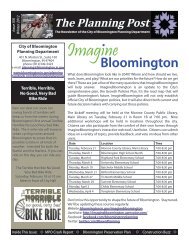Peak Oil Task Force Report - City of Bloomington - State of Indiana
Peak Oil Task Force Report - City of Bloomington - State of Indiana
Peak Oil Task Force Report - City of Bloomington - State of Indiana
Create successful ePaper yourself
Turn your PDF publications into a flip-book with our unique Google optimized e-Paper software.
2. Advocate a tiered pricing system whereby consumers pay a rate based on<br />
consumption.<br />
The Mayor has expressed an interest in pursuing a rate structure to encourage water<br />
conservation. 68 The proposal must be approved by the <strong>Indiana</strong> Regulatory Commission. 69<br />
A tiered‐rate structure would mean that the unit price <strong>of</strong> consumption would increase after<br />
usage exceeds a predetermined basic monthly amount. While any such rate must be non‐<br />
discriminatory (e.g., must not discriminate against larger families), linking price to use will<br />
go some distance in reducing demand – peak and otherwise. In Athens‐Clarke County,<br />
Georgia – an <strong>of</strong>t‐cited college town comparable to <strong>Bloomington</strong> – rates are based on each<br />
customer’s winter average. Officials in that community estimate that this rate structure<br />
will save approximately one million gallons <strong>of</strong> water per day in the summer when use is at<br />
its peak. 70<br />
3. Encourage rainwater capture.<br />
Outdoor water use can comprise 25% to 58% <strong>of</strong> overall domestic water demand. 71<br />
Rainwater harvesting has significant potential to reduce stormwater run<strong>of</strong>f while<br />
conserving potable water. Rainwater capture <strong>of</strong>fers a number <strong>of</strong> advantages: 72<br />
• provides an inexpensive supply <strong>of</strong> water;<br />
• reduces stormwater run<strong>of</strong>f and pollution;<br />
• reduces erosion in urban environment;<br />
• provides water that needs little treatment for irrigation or non‐potable indoor uses;<br />
• helps reduce peak summer demands; and<br />
• helps introduce demand management for drinking water systems.<br />
68 <strong>State</strong> <strong>of</strong> the <strong>City</strong> Address, 2009.<br />
69 <strong>Indiana</strong> Code § 8‐1.5‐3‐8 governs rates and charges for municipal utilities and requires that rates must be<br />
"nondiscriminatory, reasonable, and just." "Reasonable and just" charges are defined as paying for all <strong>of</strong> the<br />
necessary costs <strong>of</strong> the utility, including maintenance, operating charges, upkeep, repairs, depreciation, bond<br />
interest, and the costs <strong>of</strong> extensions and replacements.<br />
70 http://www.athensclarkecounty.com/documents/pdf/publicutilities/water_conservation_rates.pdf<br />
71 Christopher Kloss, U.S. Environmental Protection Agency, Managing Wet Weather with Green Infrastructure:<br />
Municipal Handbook – Rainwater Harvesting Policies, p.1, , EPA‐833‐F‐08‐010 (December 2008).<br />
http://www.epa.gov/npdes/pubs/gi_munichandbook_harvesting.pdf<br />
72 Texas Rainwater Harvesting Evaluation Committee, Rainwater Harvesting Potential and Guidelines for<br />
Texas, <strong>Report</strong> to the 80 th Legislature, Texas Water Development Board, Austin, TX (November 2003).<br />
<strong>Report</strong> <strong>of</strong> the <strong>Bloomington</strong> <strong>Peak</strong> <strong>Oil</strong> <strong>Task</strong> <strong>Force</strong><br />
46









